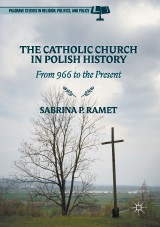Details

The Catholic Church in Polish History
From 966 to the PresentPalgrave Studies in Religion, Politics, and Policy
|
128,39 € |
|
| Verlag: | Palgrave Macmillan |
| Format: | |
| Veröffentl.: | 22.06.2017 |
| ISBN/EAN: | 9781137402813 |
| Sprache: | englisch |
Dieses eBook enthält ein Wasserzeichen.
Beschreibungen
The book chronicles the evolution of the church's political power throughout Poland's unique history. Beginning in the tenth century, the study first details how Catholicism overcame early challenges in Poland, from converting the early polytheists to pushing back the Protestant Reformation half a millennium later. It continues into the dawn of the modern age—including the division of Poland between Prussia, Russia, and Austria between 1772 and 1795, the interwar years, the National Socialist occupation of World War Two, and the communist and post-war communist eras—during which The Church only half-correctly presented itself as a steadfast protector of Poles, with clergy members who either stood up to foreign authorities or collaborated with those same Nazi and Communist leaders. This study ends with a consideration of how the Church has taken advantage of the fall of communism to push its own social agenda, at times against the wishes of most Poles.
1. Introduction.-2. From the Origins to 1772.-3. The Polish Church in the Era of the Partitions, 1772-1918.-4. The Interwar Republic, 1918-1939.-5. War Years and Communism, 1939-1989.-6. Transition to Pluralism, 1989-2004.-7. Controversies in the Life of the Church.-8. Conclusion.
<p>Sabrina Petra Ramet is a Professor of Political Science at the Norwegian University of Science and Technology (NTNU), in Trondheim, Norway, and author of 12 previous books, among them: Nihil Obstat: Religion, Politics, and Social Change in East-Central Europe and Russia (Duke University Press, 1998) and The Three Yugoslavias: State-Building and Legitimation, 1918—2005 (Indiana University Press & The Wilson Center Press, 2006). She is also editor or co-editor of 34 books published to date.</p>
The book chronicles the evolution of the church's political power throughout Poland's unique history. Beginning in the tenth century, the study first details how Catholicism overcame early challenges in Poland, from converting the early polytheists to pushing back the Protestant Reformation half a millennium later. It continues into the dawn of the modern age—including the division of Poland between Prussia, Russia, and Austria between 1772 and 1795, the interwar years, the National Socialist occupation of World War Two, and the communist and post-war communist eras—during which The Church only half-correctly presented itself as a steadfast protector of Poles, with clergy members who either stood up to foreign authorities or collaborated with those same Nazi and Communist leaders. This study ends with a consideration of how the Church has taken advantage of the fall of communism to push its own social agenda, at times against the wishes of most Poles.
Provides the first history of the Church in Poland from a political perspective Reflects research in Polish-, German-, and English-language materials Offers a detailed examination of the Church’s experiences in each of the three partition zones (Prussian/German, Russian, and Austrian) in the years 1772-1918 Includes a detailed account of the Church’s fortunes in the interwar years, 1918-1939, noting divisions within the ranks of the episcopate and the persistence of anti-Semitism in the Church Brings the story up to date, with detailed analyses of both the communist and post-communist eras in the life of the Church in Poland.
<p><br></p>
“…a sophisticated narrative, rich in details, which challenge[s]...popular beliefs and attitudes concerning the close and supportive connection between the Catholic Church and Poland....<i>The Catholic Church in Polish History: From 966 to the Present</i> is an engaging text, useful as a general introduction to the themes of religion and politics in Poland. The breadth of concrete detail is impressive, as is the ability of the author to synthesize disparate events into a coherent narrative whole.” (Michael A. Guziik, S.J., The Polish Review)<div><br></div><div>“Ramet correctly emphasizes three main themes in the book. The first of these is the fact that the Roman Catholic Church historically prioritized its own institutional well-being over that of the nation or state. Second, the Church ended up propagating a heroic (and only partially accurate) narrative of the Church's role in the Polish past, a narrative of religious resistance in the fact of oppression—this even when the majorityof clergy served as examples of accommodation and/or collaboration with the powers-that-be. Third, Ramet hones in on the connection between the Church and nation, which she sees as only ‘forged in the era of the partitions...the overall argument of a politicized Catholic Church that all too often saw itself as being under siege, even when it was not, is sound.’” (Patrice M. Dabrowski, Nationalities Papers)</div>

















